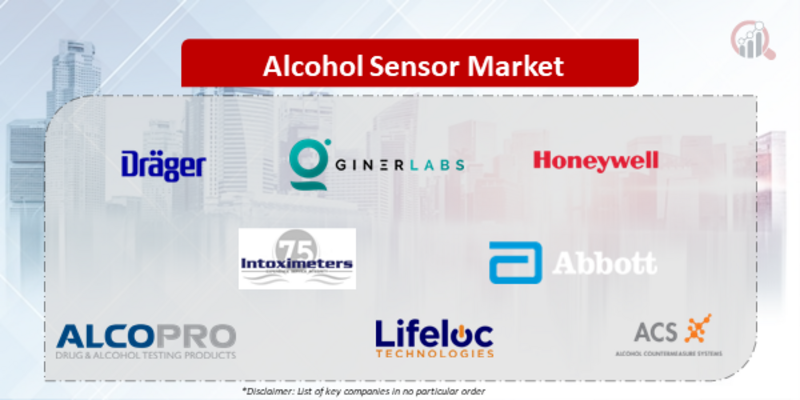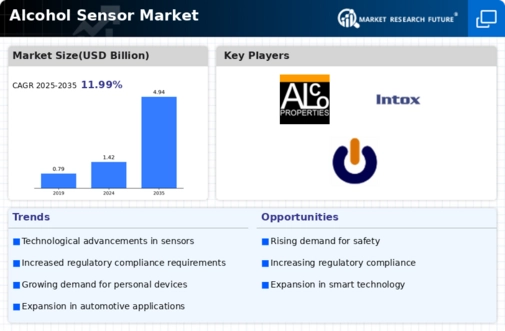Top Industry Leaders in the Alcohol sensor Market

The Competitive Landscape of the Alcohol Sensor Market
The alcohol sensor market, encompassing devices detecting and measuring blood alcohol content (BAC), navigates a dynamic landscape fueled by concerns about public safety, workplace regulations, and personal wellness. Established players jostle with innovative startups, offering diverse solutions across various applications, from breathalyzers in law enforcement to wearable monitors for personal breath analysis.
Some of the Alcohol Sensor companies listed below:
- Dragerwerk AG & Co. KGaA
- Giner Labs
- Honeywell International Inc.
- AlcoPro Inc.
- Intoximeters Inc.
- BACKtrack Inc.
- Lifeloc Technologies
- Abbot Laboratories
- Alcohol Countermeasure System (international) Inc.
- Asahi Kasei Corporation
Strategies Adopted by Leaders
- Portfolio Diversification: Offering a range of alcohol sensors catering to different applications, from high-precision evidential breathalyzers for legal use to portable and affordable breathalyzers for personal use, expands market reach and attracts diverse customer segments.
- Technological Innovation and Feature Integration: Continuous investment in R&D focuses on advancements like faster response times, improved accuracy, integration with data management systems, and connectivity with mobile devices for remote monitoring.
- Focus on Specificity and Interference Reduction: Developing sensors with high selectivity for alcohol and minimizing interference from other substances like mouthwash or certain foods builds trust and ensures reliable BAC readings.
- Strategic Partnerships and Collaborations: Partnering with law enforcement agencies, healthcare providers, and technology companies accelerates technology adoption, expands distribution channels, and fosters joint development projects.
- Focus on User Experience and Ease of Use: Designing intuitive and user-friendly devices with clear instructions and data visualization enhances user experience and encourages wider adoption, particularly for personal breathalyzers.
Factors for Market Share Analysis:
- Accuracy and Reliability: Delivering precise and consistent BAC measurements within legal tolerances sets players apart and is crucial for applications like law enforcement and workplace testing.
- Portability and Ease of Use: Compact and user-friendly devices with simple operation and clear displays cater to personal use and on-site testing in various settings.
- Cost-Effectiveness and Price Point: Striking a balance between performance, features, and competitive pricing is crucial for attracting budget-conscious customers and expanding market penetration.
- Data Management and Connectivity: Integration with data management software, cloud storage, and smartphone connectivity facilitates record keeping, remote monitoring, and data analysis for various applications.
- Brand Reputation and Regulatory Compliance: A trusted brand image built on reliable sensors, adherence to legal regulations, and certifications for specific applications fosters customer trust and opens doors to government contracts.
New and Emerging Companies:
- Niche Market Focus: Targeting specific segments like wearable breathalyzers for personal monitoring, discreet keychain breathalyzers for social settings, or low-cost disposable breathalyzers for occasional use opens up new market opportunities.
- Focus on Advanced Technologies: Integrating technologies like electrochemical sensors with enhanced sensitivity, biosensors for non-invasive breath analysis, or AI-powered data analysis positions them at the forefront of future market trends.
- Direct-to-Consumer Online Sales: Utilizing online platforms and social media marketing enables them to bypass traditional distribution channels and reach customers directly, often at competitive prices.
- Focus on Gamification and Personal Wellness: Developing breathalyzers with gamified features, smartphone app integration, and personalized BAC tracking tools caters to the growing emphasis on personal health and responsible drinking.
Industry Developments:
Sep. 29, 2023- The Connecticut Department of Transportation (CTDOT) launched the Driven to Protect initiative to advance innovative alcohol detection technology to end drunk driving. The Driven to Protect Initiative seeks to end drunk driving by advancing the development of Driver Alcohol Detection System for Safety (DADSS) technology. The DADSS system is designed to reliably, accurately, and passively detect if alcohol concentration in the driver's blood is at or above the legal limit and prevent the vehicle from moving.
Jun. 13, 2022- Researchers at the University of California San Diego announced the development of a miniaturized, fully integrated microneedle sensor that continuously monitors glucose, lactate, and alcohol levels in interstitial fluid (ISF, the fluid present between cells and tissues). The microneedle-acquired data against parallel lab-based measurements using standard reference methods. This microneedle technology accurately monitors fluctuating levels of single analytes, as well as multiplexed combinations (lactate–glucose and alcohol–glucose), in response to stimuli associated with exercise and food/alcohol consumption.
May 09, 2023- The research team at Indiana University announced the development of the first open-source model that can translate transdermal alcohol content from data collected from skin secretions into information. The monitors can help researchers study alcohol use and the development of chronic disease. The research team used machine learning and signal filtering to create a successful model to read the transdermal alcohol content.
Jan. 11, 2023- BYD Watch announced its smartwatch patent with alcohol detection capability was approved. The Apple Watch-like design patented in China comes with an alcohol detection function. The approval by the country's intellectual property office is a critical step in the evolution of the smartwatch. In addition to detecting alcohol intake, the BYD smartwatch design includes other health sensors, such as heart rate, body temperature, blood oxygen levels, and blood pressure monitoring.








